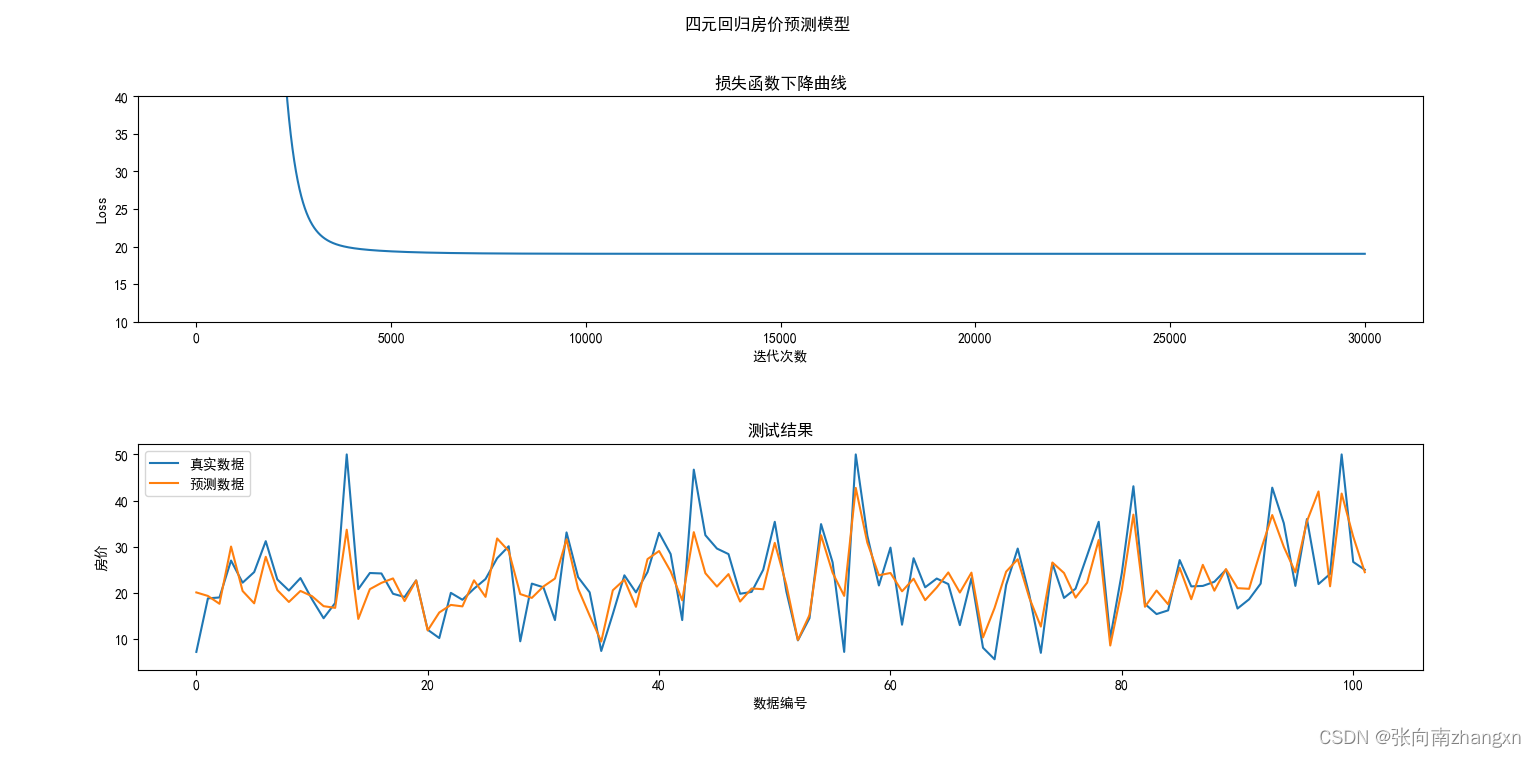利用梯度下降法,对房间数、与市中心距离、是否被河流穿过和当地师生比例四个因素建立四元回归模型。构造矩阵X,行数404(训练集中数据条数),列数5。前四列分别为以上述四个自变量为元素的列向量,第四列为全1列向量(作为偏置中的系数)。构造矩阵,前四个元素为上述四个自变量对应的权重,最后一个元素与1的乘积作为偏置。对于每组数据,利用均方差函数作为损失函数:
其中
用Y表示因变量组成的列向量,于是对于上述矩阵,有
不过由于tensorflow自带计算各元素幂的函数,所以编程中没有使用第二个方程。
代码如下:
import tensorflow as tf
import numpy as np
import matplotlib.pyplot as plt
def delta(x,w,y):
trans=tf.transpose(x)
sec=tf.matmul(x,w)-y
delt=2*tf.matmul(trans,sec)
return delt
boston_housing=tf.keras.datasets.boston_housing
(train_x,train_y),(test_x,test_y)=boston_housing.load_data()
train_y=tf.constant(train_y,dtype=tf.float32)
train_y=tf.reshape(train_y,[-1,1])
#训练集数据提取
t_room=tf.constant(train_x[:,5],dtype=tf.float32) #房间数
t_dis=tf.constant(train_x[:,7],dtype=tf.float32) #与市中心的距离
t_chas=tf.constant(train_x[:,3],dtype=tf.float32) #是否被河流穿过
t_ptra=tf.constant(train_x[:,10],dtype=tf.float32) #师生比例
x0=tf.ones(len(t_room),dtype=tf.float32)
#测试集线性归一化
t_room==tf.divide(t_room-tf.reduce_min(t_room), tf.reduce_max(t_room)-tf.reduce_min(t_room))
t_dis=tf.divide(t_dis-tf.reduce_min(t_dis), tf.reduce_max(t_dis)-tf.reduce_min(t_dis))
t_ptra=tf.divide(t_ptra-tf.reduce_min(t_ptra), tf.reduce_max(t_ptra)-tf.reduce_min(t_ptra))
X=tf.stack((t_room,t_dis,t_chas,t_ptra,x0),axis=1)
tf.random.set_seed(2)
W=tf.random.uniform([5,1],20,60)
msc=[]
#超参数控制
n=float(input("输入学习速率(建议小于0.00006):")) #学习速率
times=int(input("输入迭代次数(建议小于100000):")) #迭代次数
counter=0
percentage=0
for i in range(times):
Y=tf.matmul(X,W)
t=train_y-Y
sq=tf.square(t)
Loss=tf.reduce_mean(sq)/2
msc.append(Loss)
W=W-n*delta(X,W,train_y)
counter+=1
if (counter/times*100)%10==0:
percentage+=10
print("proceeding:%%%d" %(percentage))
print("finished. Graph is loading...")
#测试集数据提取
test_r=tf.constant(test_x[:,5],dtype=tf.float32)
test_d=tf.constant(test_x[:,7],dtype=tf.float32)
test_c=tf.constant(test_x[:,3],dtype=tf.float32)
test_p=tf.constant(test_x[:,10],dtype=tf.float32)
x0=tf.ones(len(test_r),dtype=tf.float32)
#测试集线性归一化
test_r==tf.divide(test_r-tf.reduce_min(test_r), tf.reduce_max(test_r)-tf.reduce_min(test_r))
test_d=tf.divide(test_d-tf.reduce_min(test_d), tf.reduce_max(test_d)-tf.reduce_min(test_d))
test_p=tf.divide(test_p-tf.reduce_min(test_p), tf.reduce_max(test_p)-tf.reduce_min(test_p))
Xt=tf.stack((test_r,test_d,test_c,test_p,x0),axis=1)
Yt=tf.matmul(Xt,W)
plt.figure()
plt.rcParams["font.sans-serif"]=["SimHei"]
plt.subplot(2,1,1)
plt.plot(tf.reshape(msc,[-1]))
plt.ylim(10,40)
plt.xlabel("迭代次数")
plt.ylabel("Loss")
plt.title("损失函数下降曲线")
plt.subplot(2,1,2)
plt.plot(test_y,label="真实数据")
plt.plot(Yt,label="预测数据")
plt.xlabel("数据编号")
plt.ylabel("房价")
plt.title("测试结果")
plt.tight_layout(rect=[0,0,0.95,0.95])
plt.suptitle("四元回归房价预测模型")
plt.legend()
plt.show()
输入学习速率0.00006,迭代次数30000,得到如下结果:

























 567
567











 被折叠的 条评论
为什么被折叠?
被折叠的 条评论
为什么被折叠?










